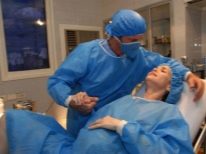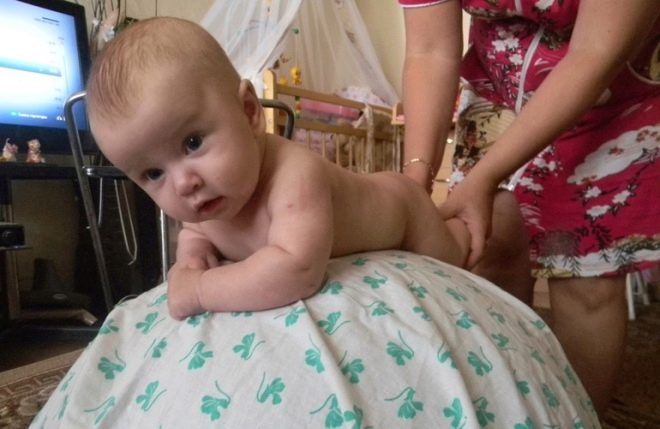Why the child does not hold his head in 3 months and what should the parents do?
Existing standards state that the infant should begin to keep the head upright by about three months, while the first attempts to lift the head while lying on the stomach should be fixed from about 2 months. There is nothing surprising in the fact that mothers and fathers, whose crumbs in 3 months do not hold their heads or do so extremely uncertainly, begin to worry and worry about the health of the little ones. In this material, we consider what could be the reasons for the lag in physical development and what should be the actions of adults.
Illness or norm?
If the baby doesn’t hold his head well in his 3 months old or doesn’t hold it, it’s not entirely correct to speak about the lag in development. Late maturation can only be an individual trait of a particular toddler. The norms are created by pediatricians based on the observation of a great many children. Some of them began to keep their heads early, and some - late. So it turned out that the most notorious "average temperature in the hospital."
If a child can not fully hold the head to the age of three months, it is not at all necessary that he has any pathological reasons. It would be a mistake to consider him inferior, lagging or sick. Also, mom should not rely on reviews on the Internet, often they simply do not correspond to reality. And certainly not related to a specific child, whose parents are alarmed by the lack of skill.
There are not so many pathologies that entail the complete impossibility of raising the head. In infancy, it is mainly cerebral palsy and severe injuries of the cervical spine. About such pathologies, if they exist, by 3 months usually parents already know. And not even because of the inability of a child to raise his head, but according to other, more obvious, signs: absent facial expression, emotional vacuum, and abundant neurological syndromes (paralysis, paresis).
If a neurologist and a pediatrician do not state anything like that, they do not make a diagnosis of the child on the card, then there is nothing to worry about. The ability to hold the head is one of the initial motor skills that the child will master, but only after he has such a physical opportunity: the neck muscles and vertebrae will strengthen.
If these muscles are immature, then it will be very difficult to keep the weight of your own head (and in newborns it is one of the most "weighty" parts of the body).
Therefore, it is more correct to understand not for what painful reason a child in 3 months may not hold his head, but in what factors contribute to the weakness of the muscles of the neck of the crumbs.
The reasons
The reasons for the baby does not keep his head in the existing average time can be as long as you want. Consider the most common ones.
- Prematurity If the baby is in a hurry to be born, then his bone and muscle tissues will get stronger later, since he needs more time to adapt to new conditions of habitat, unlike intrauterine ones. By 3 months, many premature babies are just beginning to raise the head and hold it for no more than half a minute.
- Fetal trouble. If the mother’s pregnancy was severe (with toxicosis, preeclampsia, signs of placental insufficiency and chronic fetal hypoxia), then this will leave a mark on the baby’s health for a few more months. It will be somewhat weaker than its peers, and therefore such a baby may also begin to hold its head later.
- Heavy and pathological childbirth. Even if during pregnancy the fetus did not experience a negative impact, severe childbirth could provoke a state of acute hypoxia. Such births include rapid or prolonged delivery, a long stay of the child without amniotic fluid, weak labor pains, premature detachment of the placenta. The state of oxygen starvation in the first place "hits" on the brain, but because the development of the baby may be somewhat slow.
- Congenital and acquired diseases. Children with illnesses of congenital origin, as well as often sick children who were born healthy, spend a lot of effort to fight diseases, and therefore their muscles are weaker, and the motivation to explore the world around them is lower. Any motor skills, including holding the head vertically, they are given more difficult and master them longer.
- Weight. As already mentioned, to keep the head, the back muscles of the neck should be sufficiently developed, and for turning the head in an upright position, developed lateral neck muscles are needed. If the child is overweight, then it will be more difficult, since the load will be higher. Weakness and hypotonia of the cervical muscles are characteristic of children born with underweight. Before they start to lift and hold their heads, they need to gain body weight to normal age values.
- Character and temperament. Everyone has his own unique character. Children are no exception. If a three-month-old child was born a lazy and inactive melancholic, then he is more happy with a full meal and a good sleep, while the sanguine person is interested in everything around, he is very inquisitive and from an early age begins to try to acquire new skills in order to gain additional opportunities in exploring the surrounding space. .
- Environment and habitat conditions. Children with whom mothers practice, which they sing, communicate with, do gymnastics, temper from birth, do not set aside a walk on the street for later, usually comprehend everything new, than babies with whom adults do not do it or rarely do it.
Opinion of Dr. Komarovsky
Yevgeny Komarovsky, a well-known children's doctor, TV presenter and author of books on children's health, recommends not to panic, if at 3 months the child does not hold the head well enough. It is important, in his opinion, not even the lack of skill, and associated symptoms. If there is no complaint about anything and a head that hardly rises and almost does not stand upright, is the only complaint of the parents, then most likely there is no reason for excitement.
When other disturbing symptoms appear (the child has a poor appetite, he often cries and cries for no reason, there were convulsions, the crumb does not try to smile to his mother, does not recognize her and doesn’t liven up at her sight, does not react to tender treatment, sounds) It is necessary to refer to a pediatrician and a neurologist.
If the baby develops as an ordinary baby and at the same time simply does not hold the head at this age, the parents can cope with the problem themselves, since they themselves have created it. They will come to the aid of massage, gymnastics, proper care for the child.
What to do?
To calm you can talk to the local pediatrician, who will confirm that the baby does not have serious diseases, and also exclude the presence of torticollis - a pathology that prevents you from keeping the head in a straight position. Then you can move on to a set of measures that will strengthen the neck muscles of the infant.
Massage. Massage the neck carefully, avoiding intense rubbing in the neck area. In 3 months it is best to limit yourself to stroking the back of the neck and its lateral sides with an open palm.
Avoid cervical vertebra massage.
- Gymnastics. Include in the complex exercises that have a positive effect on the neck muscles, causing them to strain.This is a large complex of pulling exercises on the abdomen, swinging the child on the fitball back and forth, left and right, as well as “Samoletik” - an exercise in which the baby lies on the mother’s arms with her stomach, and she lifts it somewhat above the surface of the massage table. This causes the baby to bend back, raise his head and spread his arms to the side to maintain balance.
- Lie on your belly more often. Laying on the stomach is not only an effective way to cope with increased gas formation in the intestines, but also an excellent load for the neck muscles. The more often the baby will lie on the tummy during wakefulness, the better. But you should not put him to sleep on his stomach: posture is unsafe. Put the child to sleep on its side, but make sure that each time the side was opposite. It will be an excellent prevention of torticollis - neck muscles will develop symmetrically.
Swimming. Baby can swim for a month. If he was not yet able to do this before the age of three months, it's time to do it. You can go to any pool or water sports palace, where there are special groups for infants. And you can let the child swim in a large home bath. To do this, you need a special rubber ring on the neck, such as are sold in any children's store or orthopedic salon. You can also hold the child under the tummy and "roll" on the water back and forth (option "Samoletika", but only in the water). While in the water in a child, all muscle groups are strengthened faster.
Do not forget about the benefits of bright toys. Hang them over the crib, use while laying on the belly.
For information on how parents can help a child learn how to hold a head, see the following video.





















